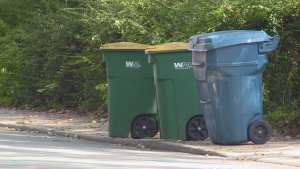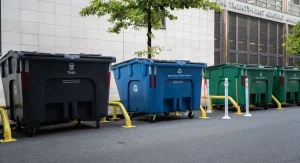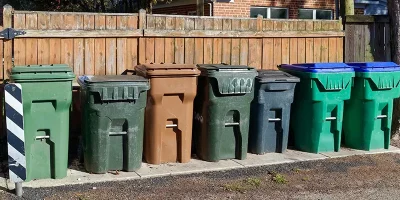When it comes to waste management, the dimensions of trash cans play a crucial role in efficient disposal. Choosing the right trash can size is more than just a matter of capacity; it’s about optimizing space, managing different types of waste, and contributing to sustainable practices.
From small household bins to large industrial containers, understanding trash can sizes is fundamental for effective waste disposal and environmental responsibility. In this exploration of trash can sizes and waste management, we’ll delve into the considerations that shape the dimensions of these containers and their significance in fostering responsible waste practices.
What are the standard sizes for household trash cans?

Household trash cans come in various sizes to accommodate different needs. While there is no universally standardized size, common sizes are available to suit typical household requirements. Here are some standard sizes for household trash cans:
- Kitchen Trash Cans:
-
- Small: 8-10 gallons
- Medium: 12-16 gallons
- Large: 20+ gallons
- Bathroom Trash Cans:
-
- Small to Medium: 2-5 gallons
- Outdoor Trash Cans (for curbside pickup or outdoor use):
-
- Medium: 20-32 gallons
- Large: 35-64 gallons
It’s important to note that these sizes can vary by brand and model. When choosing a trash can size, consider the amount of waste your household generates, how often you want to empty the trash, and the available space in your home. Additionally, some households may use multiple trash cans for recycling purposes, with separate bins for paper, plastic, glass, and other recyclables.
Regulations for trash can sizes in waste management
Trash can size regulations in waste management can vary depending on the local or regional policies and the waste management system in place. Different municipalities and waste management authorities may have specific rules and guidelines regarding the size, type, and placement of trash cans. Here are some common aspects regulated by waste management authorities:
- Container Size Limits:
-
- Many areas specify the maximum size of trash containers allowed for residential use. This helps ensure that the containers are manageable for collection and do not pose safety risks.
- Weight Limits:
-
- There may be regulations on the maximum weight a trash container can have. This is to ensure the safety of waste collection workers and the efficiency of collection processes.
- Type of Containers:
-
- Some areas may have rules about the type of containers allowed. For example, they may require the use of specific types of bins or bags that are compatible with their waste collection equipment.
- Separation of Waste:
-
- Regulations may encourage or mandate the separation of different types of waste, such as recyclables, organic waste, and general trash. Some areas may require residents to use separate containers for recycling.
- Collection Schedules:
-
- Waste management regulations often include guidelines for the timing and frequency of waste collection. This can include specific days for trash pickup, rules for bulk item disposal, and other scheduling details.
- Placement of Bins:
-
- Rules about where residents should place their trash containers for collection can also be part of waste management regulations. This may include guidelines on curbside placement or designated collection areas.
It’s essential to check with the local waste management authority or municipality to understand the specific regulations that apply to your area. These regulations aim to streamline the waste collection process, promote recycling, and ensure the safety and efficiency of waste management operations. Violating these regulations may result in fines or other penalties.
What size trash can is suitable for a small apartment?

The size of a trash can for a small apartment can depend on factors such as the number of people living in the apartment, personal habits, and how frequently you want to empty the trash.
However, a common recommendation for a small apartment is to use a trash can with a capacity of around 10 to 13 gallons (38 to 49 liters). This size is typically large enough to handle the waste generated in a small space without taking up too much room.
Keep in mind that you might also want to consider the design and features of the trash can, such as a lid to contain odors, a foot pedal for hands-free operation, and ease of cleaning. Additionally, if space is limited, you might want to opt for a slim or narrow design that can fit into tight spaces.
Are there eco-friendly options for larger outdoor trash cans?
Yes, there are eco-friendly options for larger outdoor trash cans. When choosing an eco-friendly outdoor trash can, consider the following:
- Recycled Materials: Look for trash cans made from recycled materials. Many manufacturers produce bins using recycled plastic or other sustainable materials.
- Biodegradable Bags: Use biodegradable or compostable trash bags in the outdoor trash can. These bags break down more easily than traditional plastic bags, reducing environmental impact.
- Sustainable Materials: Choose trash cans made from sustainable materials such as bamboo, metal, or wood. These materials are often more durable and have a lower environmental impact than traditional plastic.
- Solar-Powered Compactors: Some outdoor trash cans come with solar-powered compactors that reduce the need for frequent emptying, saving energy and reducing transportation emissions.
- Dual Bins for Recycling: Look for outdoor trash cans with separate compartments for recycling and general waste. This encourages proper waste separation and recycling.
- Powder-Coated Finishes: Opt for outdoor trash cans with powder-coated finishes, as these finishes are often more environmentally friendly than traditional paints.
- Smart Waste Management Systems: Consider smart waste management systems that use sensors to optimize trash collection routes, reducing fuel consumption and emissions.
When shopping for an eco-friendly outdoor trash can, check the product specifications and descriptions to ensure that it meets your sustainability criteria. Additionally, some local waste management programs may have specific guidelines for outdoor trash cans, so it’s worth checking with your local municipality for recommendations or requirements.
Common sizes for commercial trash bins in businesses
Commercial trash bins in businesses come in various sizes to accommodate different waste disposal needs. The size of the trash bin depends on factors such as the type of business, the amount of waste generated, and the frequency of waste removal. Here are some common sizes for commercial trash bins:
- Small Bins (2-5 Gallons): These are often used in individual offices, restrooms, or small businesses with minimal waste generation.
- Medium Bins (10-20 Gallons): Suitable for small to medium-sized businesses, these bins are often found in break rooms, kitchens, and areas with moderate waste production.
- Large Bins (30-40 Gallons): Larger businesses or those with higher waste volumes may use these bins in communal areas, lobbies, or high-traffic zones.
- Extra-Large Bins (50+ Gallons): Industries with substantial waste production, such as restaurants, supermarkets, or manufacturing facilities, may require extra-large bins to handle the increased volume.
- Dumpster Sizes (2-8 Cubic Yards): For businesses with significant waste output, dumpsters are common. Sizes can vary, with smaller dumpsters suitable for smaller businesses, and larger dumpsters for industries generating a substantial amount of waste.
It’s essential for businesses to assess their waste management needs and choose appropriate bin sizes to ensure efficient and timely waste removal. Additionally, businesses should consider implementing recycling programs and providing separate bins for recyclables to promote sustainability. Local waste management regulations and services may also influence the choice of commercial trash bin sizes.
Conclusion
If you need the right info on trash can sizes waste management, then you are just in the right place. In waste management, choosing the right trash can size is crucial for efficiency and sustainability. For small apartments, a 10 to 13-gallon capacity is often suitable. In commercial settings, sizes vary based on the business type, with small bins for offices and larger options, including dumpsters, for industries with higher waste volumes.
Eco-friendly options, such as using recycled materials, biodegradable bags, and sustainable designs, contribute to responsible waste disposal. Tailoring trash can sizes to the specific needs of a space, coupled with environmentally conscious choices, supports effective waste management practices.


